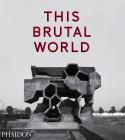Art Of The Day Weekly
#458 - from 2 February 2017 to 8 February 2017
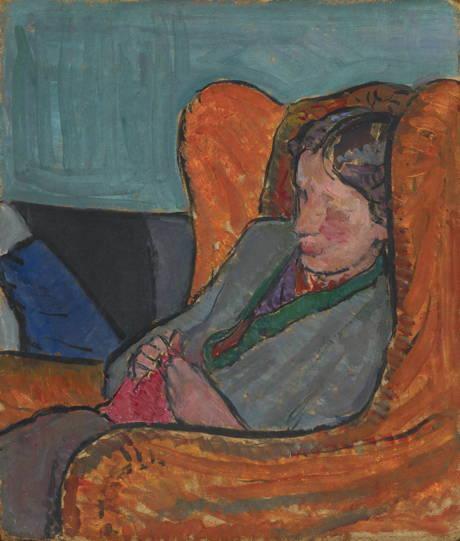
Vanessa Bell, Virginia Woolf, c. 1912, oil on board, 40 x 34 cm. © National Portrait Gallery, London, NPG 5933.
IN THE AIR
Vanessa, Virginia Woolf’s talented sister
DULWICH - She is not as well known as her younger sister, Virginia Woolf. But Vanessa Bell’s life was much longer (1879-1961) and probably more exciting. She soaked in the famous Bloomsbury group, was married to a brilliant critic, Clive Bell, collected lovers -Roger Fry, Duncan Grant – and not only left a mark in her time due to her mundane adventures but also by her painting. Indeed she was among the first artists to launch herself into Abstract art in England, right before World War I and she merged the avant- garde movements – such as Cubism, Fauvism or Rayonism- in a very personal way. The exhibition presents some one hundred works and also shows her intense activity in applied arts with the Omega Workshops, a field in which she produced motifs for textiles and furniture. Her mansion in Charleston, in Sussex, hosted all the intelligentsia of her time, from Aldous Huxley to Maynard Keynes. But her later decades, during which she suffered the death of her son in the war in Spain in 1937, and the suicide of Virginia in 1941, were much less productive.
• Vanessa Bell at the Dulwich Art Museum, from 8 February to 4 June 2017.
EXHIBITIONS
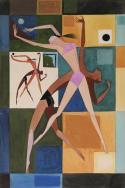
José de Almada Negreiros, Untitled, undated, graphite and gouache on cardboard, 53.5 x 36 cm. Private collection.
A Portuguese Picasso
LISBON – His life was almost as long as that of the great Spaniard. José de Almada Negreiros, born in 1893, created until his death, in 1970. He may have missed Cubism by an inch –or a few years- but he embraced all the other styles of Modernism. He was a close friend of Fernando Pessoa’s, whose work he illustrated, also made the most famous portrait of the author, and finished his work in an entirely geometric phase. In the meantime, he was the spearhead of Futurism in Portugal with is friend Santa-Rita. He gave sufficient proof of his virtuosity in Figurative art, such as we can se in his self-portraits from the 20s, in the manner in which he dealt with social subjects – peasants, immigrants- in a style that recalls that of Fernand Léger or Picabia. We can also see a ‘closeness’ with Picasso in the interest he had in avant-garde ballets, in certain themes such as the circus acrobats, and the number of supports he used in doing his work. He too expressed himself clearly and with conviction, “Look clearly at my eyes, they are not mine, they are the eyes of the century”, or “To be modern is just like being elegant: it is not a way of dressing but rather a way of being”. Following the exhibit of Souza Cardoso last year at the Grand Palais in Paris, here is a tribute to another great name from Portugal.
• José de Almada Negreiros at the Gulbenkian Foundation, from 3 February to 5 June 2017.
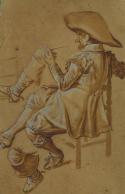
Dirck Hals, Studies of a man sitting, smoking a pipe, and of two legs, 1622-1627, paint brush and brown ink, brown paint, highlights in white gouache on a sketch in black stone, 277 x 178 mm © Rijksmuseum, Amsterdam.
In search of Dutch drawings
PARIS – It is well known that the very active painters of the 17th century never painted directly from the motif like the Impressionists – due to the simple fact they did not have tubes of paint! But when they did paint on the field it was strangely quite difficult to match precise drawings to finished paintings. This exhibition, which already showed in the USA, is a ‘first time’ since it manages just that for certain major painters. One sees how Cuyp could sketch a topographic view and a few placid cows before bringing the two together in a painting that was perfected in his workshop. For Rembrandt, there is a Saint John the Baptist preaching, painted during his youth (1634), that is put side by side with his preparatory drawings. The exercise required the talent of a detective – or two or three- and crossing borders. For a scenes of a countryside inn by van Ostade for example, kept at the museum of Saint-Louis, Missouri, two studies of peasants dancing were found, one at the Rijksmuseum in Amsterdam, the other at the Kunsthalle in Hamburg.
• Du dessin au tableau au siècle de Rembrandt at the Fondation Custodia, from 4 February to 7 May 2017.
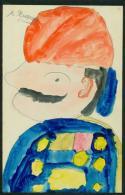
Tsarevitsj Aleksej Nikolajevitsj, Portrait of a military, watercolour on paper © GARF, State Archive of the Russian Federation
1917, the end of the Romanov family
AMSTERDAM – Exactly one hundred years ago, Nicholas II, the tsar of Russia, abdicated, thus putting an end to three hundred years of the Romanov dynasty. One year later, during the night from the 17 to the 18 July 1918, he and his family were summarily executed at Yekaterinburg. To mark this anniversary, the exhibition plunged into the collections of the Hermitage as well as those of the State Archives in Moscow. The objective straddles the country’s history - the development of a well-to-do class that loved art and luxury, the shock of the war – and the destiny of the royal family. The exhibition combines works of art (in particular the portraits of the tsar by Ilja Repin), reports from that period (photographs and films) and moving documents such as the act of abdication dated 2 March 1917, the first drawings of the prince with hemophilia or the last page of the empress Alexandra Fyodorovna’s diary, in which is simply written the date, 17 July 1918.
• 1917. Romanovs and Revolution at the Hermitage Amsterdam, from 4 February to 17 September 2017.
AND ALSO...
Half a century of Rouan
MONTPELLIER – François Rouan was born in Montpellier in 1943, and experienced his first artistic emotions at the Musée Fabre. The institution pays a tribute to him by organizing a visit of five decades of creation by one of the historic members of the Supports/Surfaces movement.
• François Rouan, Tressages, 1966-2016 at the Musée Fabre, from 4 February to 30 April 2017.
Di Rosa’s universe
SÈTE – What could Hyeronimus Bosch, Pierre Molinier and Orlan ever have in common? They are all part of the ‘intimate best of’ of Hervé Di Rosa, the flag bearer of ‘modest art’. The creator of the surprising museum, which bears his name, and is located in a former garage, calls in his influences.
• En toute modestie at the MIAM, from 4 February to 17 September 2017.
Giving one’s all for concrete art
STUTTGART – The passion Hans Teufel (1936-2007) had for concrete art, as theorized by Theo Van Doesburg, was born in 1955 when he was still an adolescent. But it accompanied him throughout his life as a gallery owner and as a collector and is clearly reflected in this fund given to the museum and which is shown by rotation.
• Teufel Collection at the Kunstmuseum, from 4 February to 10 September 2017.
BOOKS
The poetry of concrete
Concrete has often been criticized: a coast built up in concrete no longer attracts tourists and if Concrete art had its days of glory, those days are gone. The material though, a synonym of modern architecture, attracted pioneers such as Hennebique and Perret who did wonders with it as early as of 1900. It is capable of forming poetic shapes as long as it is poured by the right person. Le Corbusier, Louis Kahn, Marcel Breuer, Claude Parent and Niemeyer proved it over and over again. But this book enlarges the list by giving a place to architects who were highly criticized in their time, such as Paul Rudolph or Denys Lasdun, who were unknown because they came from countries that were faraway or closed to the rest of the world for a longtime –such as Argentina if we refer to Clorindo Testa, or all the thrilling monuments of the former Soviet empire, such as the Ministry of Development at Tbilissi. Actually, while this book focuses largely on concrete, Brutalist architecture, with pure and powerful shapes, can also make do with bricks and glass. And most contemporary architects - OMA, Herzog & de Meuron, Adjaye – have accomplished some pretty remarkable tests in this register.
• This Brutal World, by Peter Chadwick, Phaidon, 2016, 224 p., £29.95.

